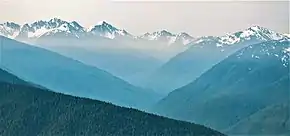Chimney Peak (Olympic Mountains)
Chimney Peak is a 6,917-foot-elevation (2,108-meter) mountain summit located within Olympic National Park in Jefferson County of Washington state. Chimney Peak is situated near the head of Elwha Valley, and immediately north above Enchanted Valley. Topographic relief is significant as the southeast aspect rises 4,800 feet (1,500 meters) above Enchanted Valley in less than one mile. Enchanted Valley is also known as Valley of 10,000 Waterfalls, and numerous waterfalls tumble down the immense cliffs of Chimney Peak.[4][5] Neighbors include Crystal Peak, 2.2 mi (3.5 km) to the north, White Mountain 3.5 mi (5.6 km) to the east, and West Peak 3.4 mi (5.5 km) to the northeast. Precipitation runoff from the mountain drains north to the Elwha River, and south to the Quinault River.
| Chimney Peak | |
|---|---|
 North aspect of Chimney Peak centered, as viewed from Hurricane Ridge. (Crystal Peak to left) | |
| Highest point | |
| Elevation | 6,917 ft (2,108 m)[1] |
| Prominence | 997 ft (304 m)[1] |
| Parent peak | West Peak (7,365 ft)[2] |
| Isolation | 3.41 mi (5.49 km)[2] |
| Coordinates | 47°41′22″N 123°24′09″W[3] |
| Geography | |
 Chimney Peak Location of Chimney Peak in Washington  Chimney Peak Chimney Peak (the United States) | |
| Location | Olympic National Park Jefferson County, Washington, US |
| Parent range | Olympic Mountains |
| Topo map | USGS Chimney Peak |
| Geology | |
| Age of rock | Eocene |
| Climbing | |
| First ascent | 1941 |
| Easiest route | class 3 scrambling via SW ridge[1] |
History
This landform was originally named "Old Snowback" in 1890 by Charles Barnes of the 1889-90 Seattle Press Expedition.[6] The mountain's present, official, descriptive name is attributable to a 100-foot-high chimney-like tower on the peak's west aspect, which is known as "The Chimney".[1][6] The first ascent of the summit was made in 1941 by Tolvo J. Nelson of the United States Geological Survey.[1] The first ascent of The Chimney was made in 1970 by Mike Banner and Vern Johnson via class 5.3 climbing.[7]
Climate
Based on the Köppen climate classification, Chimney Peak is located in the marine west coast climate zone of western North America.[8] Most weather fronts originate in the Pacific Ocean, and travel east toward the Olympic Mountains. As fronts approach, they are forced upward by the peaks of the Olympic Range, causing them to drop their moisture in the form of rain or snowfall (Orographic lift). As a result, the Olympics experience high precipitation, especially during the winter months. During winter months, weather is usually cloudy, but due to high pressure systems over the Pacific Ocean that intensify during summer months, there is often little or no cloud cover during the summer. The months June through September offer the most favorable weather for viewing or climbing this peak.[1]
Geology
The Olympic Mountains are composed of obducted clastic wedge material and oceanic crust, primarily Eocene sandstone, turbidite, and basaltic oceanic crust.[9] The mountains were sculpted during the Pleistocene era by erosion and glaciers advancing and retreating multiple times.
Gallery
References
- "Chimney Peak, climbersguideolympics.com". Archived from the original on 2021-12-24. Retrieved 2021-12-24.
- "Chimney Peak - 6,917' WA". listsofjohn.com. Archived from the original on 2021-12-24. Retrieved 2021-12-23.
- "Chimney Peak". Geographic Names Information System. United States Geological Survey, United States Department of the Interior. Retrieved 2021-12-23.
- Gregory Plumb, 2013, Waterfall Lover's Guide Pacific Northwest, 5th Edition, Mountaineers Books, ISBN 9781594857546
- Patrick Swenson, 2021, Rain Music, Fairwood Press, chapter 17.
- Parratt, Smitty (1984). Gods and Goblins: A Field Guide to Place Names of Olympic National Park (1st ed.).
- Olympic Mountain Rescue, Olympic Mountains: A Climbing Guide, 2006, Mountaineers Books, ISBN 9780898862065, page 205.
- Peel, M. C.; Finlayson, B. L.; McMahon, T. A. (2007). "Updated world map of the Köppen−Geiger climate classification". Hydrol. Earth Syst. Sci. 11: 1633–1644. ISSN 1027-5606.
- Alt, D.D.; Hyndman, D.W. (1984). Roadside Geology of Washington. pp. 249–259. ISBN 0-87842-160-2.
External links
- "Olympic National Park". National Park Service.
- Weather forecast: Chimney Peak





